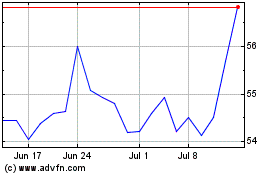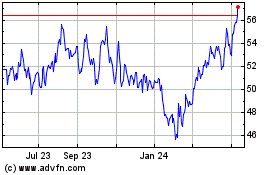National Fuel's Rate Filing Includes Incentives to Help Customers Conserve
January 29 2007 - 10:16AM
Business Wire
National Fuel Gas Distribution Corporation�s New York division (the
�Utility�), the natural gas utility serving more than 514,000
customers in Western New York, today submitted to the New York
State Public Service Commission (�PSC�) a request to re-design and
raise its Delivery Service Charges beginning in 2008. National Fuel
Gas Distribution Corporation is a subsidiary of National Fuel Gas
Company (NYSE: NFG). If approved in full, the proposed $52 million,
or 6.4 percent, increase to total revenues would raise the average
customer�s monthly budget plan bill by $7.96 in 2008. The Utility�s
request includes a significant commitment to several
conservation-based initiatives that are captured in its proposed
Conservation Incentive Program. If approved, the Conservation
Incentive Program will result in the Utility making a substantial
commitment to running extensive programs promoting the benefits of
conservation through education, rebate offers and targeted
low-income initiatives. This is only the third rate request the
Utility has filed with the PSC since 1995, an accomplishment due
largely to its successful cost-containment strategies, including
workforce reductions of more than 34 percent since 1996. The
Utility�s last request to raise its Delivery Service Charges was
submitted in August 2004. Typically, a request like this involves
an 11-month review process that includes a series of hearings.
Public statement hearings, where customers will have an opportunity
to comment on the proposal, will be scheduled by the PSC and held
in the Utility�s Western New York service area. Ronald J. Tanski,
President of the Utility, said that cost containment over the last
decade has been successful, keeping its delivery charges to
consumers stable. �This rate request reflects increases in
necessary business expenses associated with operating and
maintaining a safe and reliable pipeline system. Each year,
approximately $40 million is invested in system upgrades and
replacements on the more than 14,000 miles of pipeline the Utility
owns and operates in western New York,� Tanski said. �Our
commitment to cost containment in all sectors has allowed us to
control the Delivery Service component of a customer�s bill to the
consumer�s benefit. Now, with our proposed Conservation Incentive
Program, we will work with customers to help them find ways to save
on the Gas Cost component of their bills as well. Our plan, if
approved, will provide customers with incentives to save energy and
money while, at the same time, participating in an effort that can
help stem the growing demand for energy, reduce market prices and
mitigate the decline of an important natural resource.� Major
Elements of the Company's Filing: Operating Expenses and Revenue: $
18.5 million Rate of Return: $ 4.3 million Construction program,
Depreciation, Gas Inventory: $ 13.2 million Conservation Incentive
Program $ 12.7 million Taxes: $ 3.3 million -------------- Total
Base Rate Revenue Requirement: $ 52.0 million Proposal Includes a
New Conservation Incentive Program Plans like the Utility�s
proposed Conservation Incentive Program, that fundamentally change
traditional utility rate design and offer broad conservation
programs, have received support from numerous organizations
representing the interests of utilities, elected officials,
consumer, conservation, and environmental groups, government
agencies and others. The Utility�s Conservation Incentive Program,
as proposed, includes: A year-long initiative to promote the
benefits of conserving energy. Conservation will help customers
save money on their individual energy costs and, in the context of
the energy marketplace, will contribute to efforts to reduce demand
for natural gas, further helping to bring down market prices.
Rebates of as much as $400 for the purchase of new, energy
efficient natural gas equipment and less costly, but effective
measures like programmable thermostats. Another component of the
rebate program will include customized rebates for small,
non-residential customers who install high-efficiency natural gas
equipment. A residential customer who upgrades their furnace from a
low-efficiency model to a high-efficiency model can save more than
$300 per year by using less energy. Special programs for low-income
customers to reduce their consumption of energy and save on their
energy bills. The proposed Low Income Usage Reduction and Helping
Hands Programs will provide, at no cost, Conservation Starter Kits,
heating system safety checks, energy audits, wall and attic
insulation, the replacement of heating equipment and other energy
conservation services to qualifying low-income customers. These
programs will complement the array of other low-income programs the
Utility already has in place. Utility Bills Include Two Main
Components Customers are reminded that their monthly bill includes
the cost of the natural gas itself (Gas Supply Charges) and the
cost of having it delivered to their home or business (Delivery
Service Charges). The proposed rate increase pertains to the
Delivery Service Charge component of the Utility�s bill, an element
that has remained relatively stable since 1996. Gas Supply Charges
are, by law, passed on to customers dollar for dollar, without any
mark-up or discount and, in the winter months, can amount to as
much 80 percent of a customer�s total bill. No utility can
influence the cost of natural gas, which is determined in a
national, and increasingly international, marketplace where the
forces of supply and demand principally determine price. Prices are
impacted by events like weather, both during the winter and summer
months, availability of supply, the consequences of natural
catastrophes like hurricanes, and other things. In recent years,
energy costs have been both volatile and at record-high levels. For
example, in January 1996, National Fuel�s average residential
utility customer paid $108.11 for natural gas alone, in January
2001, gas costs rose to a peak of $266.46. Meanwhile, the Delivery
Service Charge, which is what will be examined in this rate case,
remained stable since 1996, averaging $61.46 for a customer�s
January bill between 1996 and 2007. Average Costs for Residential
Customers in western New York (Costs are based on consumption
during normal weather conditions and do not reflect budget plan
billing): � ServicePeriod Gas Supply Charges Delivery Service
Charges Total January 1996 $108.11� $65.16� $173.27� January 1997
$137.11� $67.20� $204.31� January 1998 $91.76� $67.84� $159.60�
January 1999 $86.50� $62.87� $149.37� January 2000 $93.89� $62.61�
$156.50� January 2001 $266.46� $55.27� $321.73� January 2002
$95.61� $58.50� $154.11� January 2003 $135.62� $59.79� $195.41�
January 2004 $169.20� $59.10� $228.30� January 2005 $172.23�
$57.48� $229.71� January 2006 $241.78� $61.50� $303.28� January
2007 $186.39� $60.18� $246.57� About National Fuel National Fuel
Gas Distribution Corporation is a regulated utility and is one of
the subsidiaries in the National Fuel Gas Company system. The
Utility provides natural gas service to more than 514,000 customers
in western New York. Additional information about National Fuel
(NYSE: NFG) is available at www.nationalfuelgas.com or by calling
1-800-365-3234.
National Fuel Gas (NYSE:NFG)
Historical Stock Chart
From Jun 2024 to Jul 2024

National Fuel Gas (NYSE:NFG)
Historical Stock Chart
From Jul 2023 to Jul 2024
